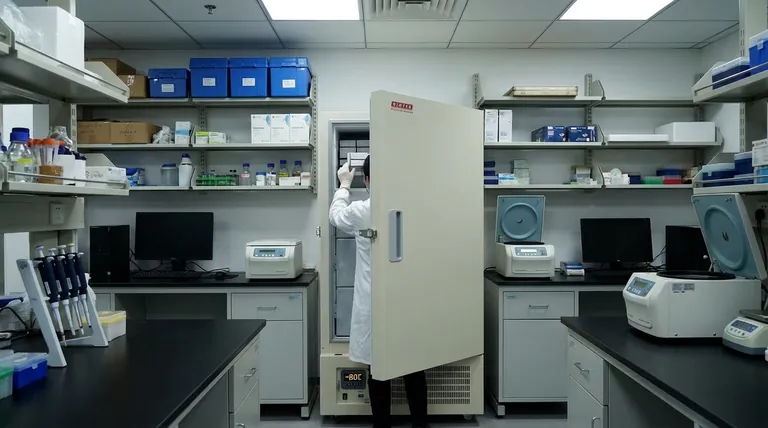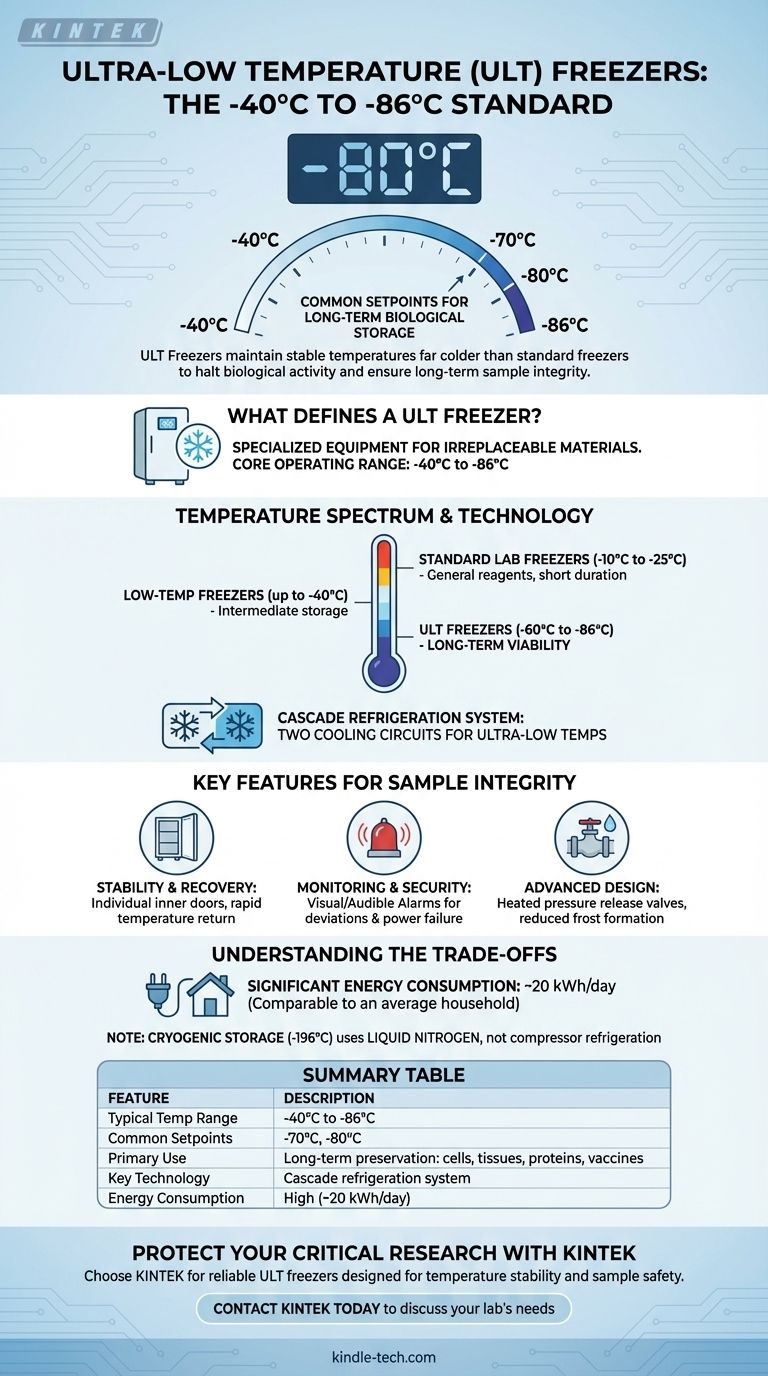In short, a typical Ultra-Low Temperature (ULT) freezer maintains a stable temperature range between -40°C and -86°C. While the exact range can vary by model, the most common setpoints for long-term biological storage are -70°C or -80°C, temperatures far colder than a standard freezer can achieve.
The core purpose of a ULT freezer is to halt biological activity, ensuring the long-term integrity of sensitive samples. Understanding their specific temperature range is the first step, but recognizing the significant operational costs and technical features is crucial for making an informed decision.

What Defines an Ultra-Low Temperature (ULT) Freezer?
ULT freezers are not simply colder versions of standard units; they are specialized pieces of laboratory equipment engineered for a specific and critical purpose: the long-term preservation of irreplaceable biological materials.
The Core Temperature Range
The operational range of -40°C to -86°C is the industry standard. This extreme cold effectively stops cellular and enzymatic activity, preventing the degradation of sensitive materials like cells, tissues, proteins, and certain vaccines over many years.
How ULT Differs from Other Lab Freezers
It's vital to distinguish between freezer types to match the equipment to the need.
- Standard Laboratory Freezers typically operate from -10°C to -25°C. They are suitable for general-purpose storage of reagents and less sensitive samples for shorter durations.
- Low-Temperature Freezers occupy a middle ground, with some models reaching -35°C or -40°C.
- ULT Freezers provide the ultra-low temperatures below -60°C necessary for long-term viability and stability of critical samples.
The Technology Behind the Cold
Achieving and maintaining such low temperatures requires a specialized approach. Most ULT freezers use a cascade refrigeration system, which involves two separate cooling circuits. The first circuit cools the second, allowing the second to reach a much lower temperature than a single system could.
Key Features for Sample Integrity
Beyond raw temperature, a reliable ULT freezer is defined by features that protect its valuable contents. The loss of samples due to equipment failure can set research back months or years.
Temperature Stability and Recovery
The internal environment must remain exceptionally stable. Features like shelves with individual inner doors minimize cold air loss when the main door is opened. A quality freezer also has a rapid temperature recovery rate to return to its setpoint quickly after access.
Monitoring and Security
Constant monitoring is non-negotiable. Visual and audible alarms for temperature deviations or power failure are standard. These systems are the first line of defense against catastrophic sample loss.
Advanced Design for Usability
Modern ULT freezers incorporate features that improve daily use and maintenance. This includes heated pressure release valves to make doors easier to open and design elements that reduce frost formation, which can compromise seals and efficiency.
Understanding the Trade-offs
The exceptional performance of a ULT freezer comes with significant operational considerations that must be factored into any decision.
Significant Energy Consumption
A ULT freezer is an energy-intensive appliance. A conventional unit can consume as much energy as an average household every day—approximately 20 kilowatt-hours (kWh). This translates to substantial long-term electricity costs.
A Note on Cryogenic Storage
Some sources may mention temperatures as low as -196°C. It is critical to understand that this is the realm of cryogenic storage, which uses liquid nitrogen, not compressor-based refrigeration. This represents an entirely different class of preservation for applications requiring the complete cessation of all biological processes.
Making the Right Choice for Your Goal
Selecting the correct cold storage solution depends entirely on the stability requirements of your samples and your timeline.
- If your primary focus is general lab storage of robust reagents: A standard
-20°Claboratory freezer is the most practical and energy-efficient choice. - If your primary focus is the long-term preservation of critical cells, enzymes, or vaccines: A ULT freezer operating between
-70°Cand-86°Cis the required standard for ensuring sample integrity. - If your primary focus is halting virtually all biological function indefinitely: You must investigate specialized cryogenic storage systems that utilize liquid nitrogen (
-196°C).
Choosing the right equipment is fundamental to protecting the integrity of your invaluable work.
Summary Table:
| Feature | Description |
|---|---|
| Typical Temperature Range | -40°C to -86°C |
| Common Setpoints | -70°C, -80°C |
| Primary Use | Long-term preservation of cells, tissues, proteins, vaccines |
| Key Technology | Cascade refrigeration system |
| Energy Consumption | High (approx. 20 kWh/day) |
Protect your critical research samples with the right equipment.
Choosing the correct ultra-low temperature freezer is essential for the long-term viability of your irreplaceable biological materials. KINTEK specializes in providing reliable lab equipment, including ULT freezers, designed to meet the rigorous demands of laboratory storage.
We can help you select a freezer that ensures temperature stability, rapid recovery, and advanced monitoring to safeguard your work. Our expertise ensures you get a solution that balances performance with operational costs.
Contact KINTEK today to discuss your lab's specific needs and find the ideal ULT freezer for your research.
Visual Guide

Related Products
- 58L Precision Laboratory Ultra Low Temperature Upright Freezer for Critical Sample Storage
- 158L Precision Vertical Ultra Low Freezer for Laboratory Applications
- 508L Advanced Vertical Ultra Low Temperature Freezer for Critical Laboratory Storage
- 408L Advanced Vertical Laboratory Ultra Low Temperature Freezer for Critical Research Material Preservation
- 108L Vertical Ultra Low Temperature ULT Freezer
People Also Ask
- What are the key construction features of ultra low temperature freezers? Essential Design for Protecting Critical Samples
- What are ultra low temperature freezers used for? Preserving Critical Biological Samples for Decades
- What is ultra-low temperature freezing and what is its primary purpose? Preserve Biological Samples for Years
- What factors should be considered when selecting an ultra-low temperature freezer? Ensure Sample Integrity and Long-Term Value
- What are ultralow temperature freezers and what are they used for? Preserve Critical Samples for Decades



















